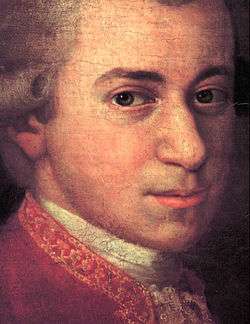Symphony No. 31 (Mozart)
The Symphony No. 31 in D major, K. 297/300a, better known as the Paris Symphony, is one of the more famous symphonies by Wolfgang Amadeus Mozart. It may have been first of his symphonies to be published when Seiber released their edition in 1779.[1]
Composition and premiere
The work was composed in 1778 during Mozart's unsuccessful job-hunting sojourn in Paris. The composer was then 22 years old. The premiere took place on 12 June 1778 in a private performance in the home of Count Karl Heinrich Joseph von Sickingen, the ambassador of the Electorate of the Palatinate. The public premiere took place six days later in a performance at the Concert Spirituel.[2]
The work received a positive review in the June 26 issue of the Courrier de l'Europe, published in London:
The Concert Spirituel on Corpus Christi Day began with a symphony by M. Mozart. This artist, who from the tenderest age made a name for himself among harpsichord players, may today be ranked among the most able composers.[lower-alpha 1] [3]
The work was performed again at the Concert Spirituel on 15 August, this time with a new second movement, an Andante replacing the original Andantino in 6/8 (the latter, according to Deutsch, "had failed to please".)[4]
The work evidently was popular. Deutsch lists several further performances at the Concert Spirituel during 1779, on 18 and 23 March, 23 May, and 3 June; and on 14 May 1780.[5] The work was published in Paris by Sieber and announced for sale 20 February 1779. During the years 1782 to 1788, Sieber's catalog described it as "in the repertoire of the Concert Spirituel".[6]
The symphony was later performed in the Burgtheater in Vienna on 11 March 1783 during a benefit concert for Mozart's sister-in-law, the singer Aloysia Weber.[7]
Instrumentation
The symphony is notable for having an unusually large instrumentation for its time, made possible by the large orchestra available to Mozart during his time in Paris. There are 2 flutes, 2 oboes, 2 clarinets in A, 2 bassoons, 2 horns, 2 trumpets, timpani, and strings. It was Mozart's first symphony to use clarinets.
Sadie remarks that this is the largest orchestra for which Mozart had yet composed in his career. The number of string players is (as usual) not specified in the score, but Sadie remarks that at the premiere there were 22 violins, five violas, eight cellos, and five basses. He adds, "[Mozart's father] Leopold remarked that, to judge by the Parisian symphonies he had seen, the French must like noisy symphonies."[8]
The music
The symphony is laid out in fast-slow-fast form, omitting the Minuet normally found in classical-era symphonies:
The first movement opens with a rising and accelerating D major scale in an effect known at the time as the Mannheim Rocket.
Both second movements still exist.[9] As does a sketch of an earlier longer version of the 6/8 Andantino.[10][11]
Critical comment
Sadie notes, reflecting on Leopold's remark given above, that indeed "Mozart's Paris Symphony is quite noisy. It has vigorous, stirring tuttis, with a lively violin line and an active line for the basses, lending the music extra animation. The actual thematic matter is relatively conventional, more a matter of figures than melodies, but there is not development as such, and most of the working-out of ideas comes at their presentation."[8]
Notes
- ↑ Original in French.
- ↑ Zaslaw 1996, p. 22
- ↑ Deutsch 1965, pp. 174, 176
- ↑ Deutsch 1965, p. 174
- ↑ Deutsch 1965, p. 178
- ↑ Deutsch 1965, pp. 185, 188
- ↑ Deutsch 1965, p. 183
- ↑ Deutsch 1965, p. 213
- 1 2 Sadie 2006, p. 474
- ↑ Tyson 1987, p. 106
- ↑ Noguchi 1998
- ↑ Tyson 1987, p. 109
References
- Dearling, Robert (1982). The Music of Wolfgang Amadeus Mozart, the Symphonies. Fairleigh Dickinson University Press. ISBN 0-8386-2335-2.
- Deutsch, Otto Erich (1965). Mozart: A Documentary Biography. Stanford: Stanford University Press.
- Noguchi, Hideo (1998). "The Autograph Manuscripts and Early Performances of Mozart's Paris Symphony, K. 297 (300a)". Mozart Studies Online.
- Sadie, Stanley (2006). Mozart: The Early Years 1756–1781. Oxford: Oxford University Press.
- Tyson, Alan (1987). Mozart: Studies of the Autograph Scores. Harvard University Press.
- Zaslaw, Neal (1996). "Audiences for Mozarts Symphonies During His Lifetime". In Churgin, Batha. Israel Studies in Musicology. 6. Jerusalem: Israel Musicological Society.
External links
- Sinfonie in D KV 297 (300a): Score and critical report (German) in the Neue Mozart-Ausgabe
- Symphony No. 31: Scores at the International Music Score Library Project
- Smith, Gary (2007). "K297/300a Symphony in D Paris". Mozartforum.com. Archived from the original on 29 September 2007.
- "Mozart:Symphony No. 31 "Paris" performed by students of the Royal College of Music". Royal College of Music (YouTube). 2014-06-13.
